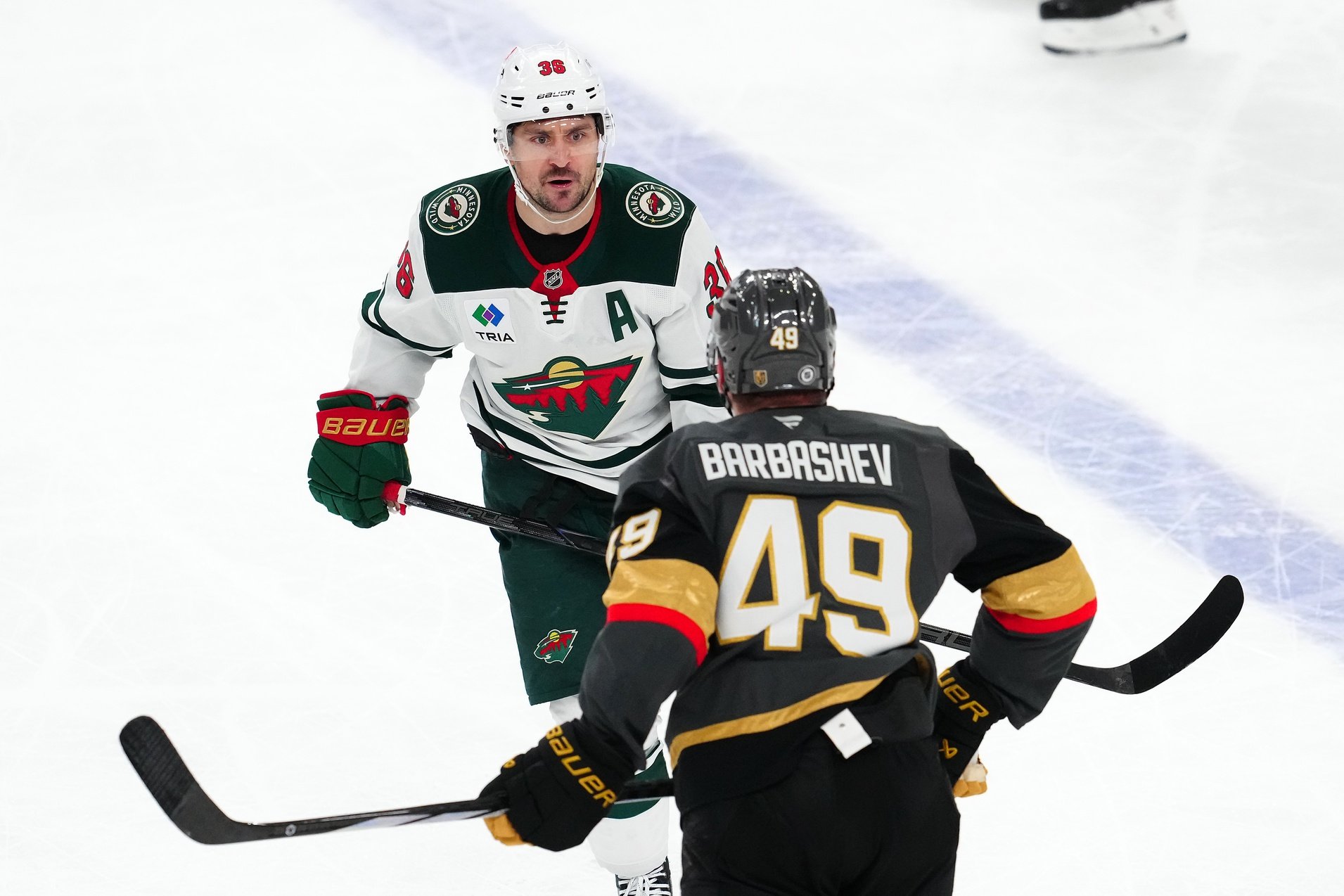
A wise man once said, “God did not send David to slay Goliath. He sent Goliath to prove to David that what resides in him is a giant slayer.”
Welcome to Round 1 against the Pacific Division champions.
The Vegas Golden Knights are tremendous offensively this year. They rank second in the league in five-on-five expected goals (xG) this season, an analytical measure of scoring chances based on shot location. According to the same analytical model, their most dangerous players also shoot at or above the NHL average.
In other words, the Knights find better scoring chances than anybody in the Western Conference, and their talent makes those chances even more valuable.
Perhaps even more intimidating, the Knights have only one player whose quality level of individual scoring chances (ixG) rank in the top 32. However, they have seven forwards who rank in the top third of the league in scoring chance value per-minute:
- Pavel Dorofeyev (31st)
- Jack Eichel (47th)
- Ivan Barbashev (53rd)
- Brett Howden (73rd)
- Nicolas Roy (88th)
- Brandon Saad (104th)
- Tomas Hertl (119th)
An average team would have only four such players. Vegas also has four defensemen in the top 51 in points-per-minute, which makes sense given that their forwards score so often.
But how do they do it? And, how can the Wild slow that down?
It’s important to understand that Vegas prioritizes high-quality scoring chances over a high volume of scoring chances. Aside from the Washington Capitals, no other team that has both an above-average level of shot attempts for an expected goals for, prioritizes scoring-chance quality over quantity.
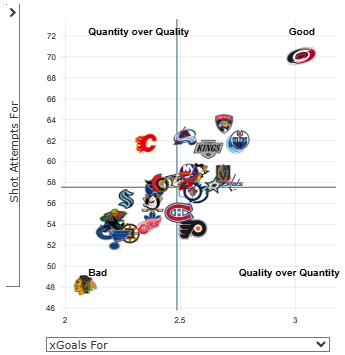
The Golden Knights achieve this steady stream of high-quality chances by involving their defensemen in the rush and their offensive zone attack. Jack Han diagrams this style of play in his book Hockey Tactics 2025.
Vegas sends two forwards deep on the breakout, occupying the other team’s defensemen. Behind those two forwards is a second wave of two more players. The fifth player passes the puck into that second wave, and those two players support each other up the ice.

If the other team pressures those two puck carriers, Vegas can make an area pass to one of the two deep forwards, threatening an odd-man rush.
When the opponent takes away the middle of the ice, Vegas has an answer. When the strong side forward (left-most player in white above) jumps the passing lane, it leaves the Golden Knights’ strong side forward open. That forward pop-passes it to the middle and joins the second wave.

Since that strong-side forward is no longer pressuring vertically, the weak-side defenseman activates to stretch the opponent’s defense horizontally.
Four players in the rush is cool. It’s sexy. Not typically the two words that people associate with an NHL head coach.
Most coaches have more conservative systems. It’s unusual to face so many four-man rushes. Therefore, most NHL teams focus on getting three players back in transition defense. That’s not enough to defend this play.
However, Vegas’s defensemen handle the puck safely, reducing the risk of a four-man rush. The Golden Knights’ opponents must choose between letting Vegas into the zone with control or pressure the puck carrier and risk an odd-man rush.
Here’s an example of how quickly this pop pass turns into a breakaway against an aggressive neutral zone defense.
Less aggressive teams face a slower death by allowing a brief four-on-three chance in their zone.
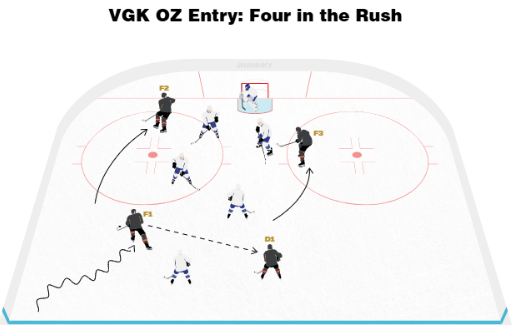
Shea Theodore victimized the Wild earlier this season on one of those “slow death” plays. Kaprizov’s back-checking does nothing to reduce the danger of this rush because the Knights have enough players to spread the zone horizontally and vertically.
The Golden Knights will only shoot these four-on-three chances opportunistically. The other advantage of the four-man rush is that it allows Vegas to set up its offense quickly. Their offense of choice is the NHL’s in-vogue shape: the 2-3.
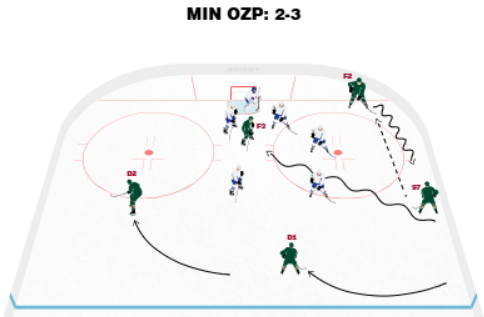
The 2-3 has two forwards deep and three players at the offensive blue line. This system's goal is to maintain possession and avoid counterattacks.
The offense can pick which side it wants to attack since there’s a point player on the left, right, and middle. If the puck-carrier gets into trouble, he can throw the puck back to the blue line or retreat to the point and restart the cycle. With so many players at the blue line, it’s very difficult for the defense to counter-attack.
That leads to long, safe possessions, but requires defensemen to handle the puck at the offensive blue line safely. Minnesota, Vegas, and the Colorado Avalanche run this system to make the most out of their deep, puck-moving defense corps.
Here’s an example of the 2-3 working to perfection:
St. Louis cannot clear the puck up the strong side, and Vegas has threats on the weak side to recover rebounds. Under the right circumstances, this creates a swarming effect that feels impossible to defend.
Vegas’s playstyle synergizes its deep defensive corps and loaded roster, creating excess value above their contracts. According to Dom Luszczyszyn’s model at The Athletic, Vegas’s defense corps has performed at the following level:
- Two “franchise” defensemen (top 16 in the league)
- Three top-pairing defensemen
- One second-pair defenseman
- One replacement-level defenseman (enforcer Nicolas Hague)
While these values can fluctuate season-to-season, Vegas’s system brings out the best in its defensemen.
Minnesota’s defensive system has a decent answer for the 2-3. When the puck is in the Wild’s zone and near the blue line, the two forwards closest to the puck defend man-on-man. The third forward defends the weak side as a zone defender.
That allows the Wild to pressure the 2-3 shape as much as possible, without exposing the slot and net-front areas as much as a true man-on-man defense. It opens the door for mistakes near the blue line and tempts Minnesota’s opponents to skate low in the zone, which can lead to rush chances for the Wild.
However, this structure offers mid-range shots if Vegas’s defensemen execute.
That covers the defensive side of the game. Minnesota matches up as well as expected, but they will need to out-score Vegas’s super-efficient offense.
Minnesota’s first offensive opportunity is on the counterattack. In reviewing the goals Vegas allowed, many came off the rush.
That may not be an option if the Vegas defense corps stays above the puck. According to data from All Three Zones, the Golden Knights only allow an average number of scoring chances off the rush.
However, Minnesota’s best bet might be the four-man breakout. The Wild have been using their mobile defensemen in the rush for years, and John Hynes hasn’t changed that. That could be a great way to get rookie Zeev Buium skating north if he debuts in this series.
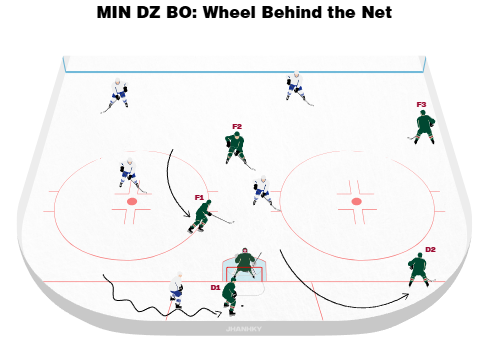
Hynes’s system typically only produces three rushers because the lowest forward covers the netfront when one of the defenseman skates behind the net. That reduces the chances of a Vegas counterattack, which helps cool off the Knights’ red-hot offense. For that reason, the Wild probably won’t adjust by using a four-man breakout.
Instead, Minnesota will probably try to gain control in Vegas’s zone and set up their own 2-3 shape. Vegas runs a “box and one” defensive zone coverage, which is probably a lot like your beer league. The defensemen and wingers form a box, and the center pressures the puck.
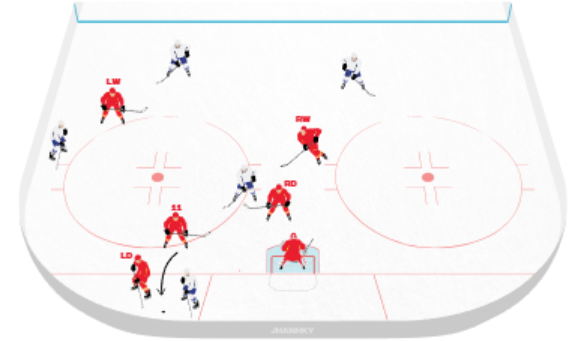
Against a box-and-one, the 2-3 makes things uncomfortable for the other team’s center. It pulls that center high in his own zone, exposing the slot. Minnesota has found offensive success against box-and-one teams this season, including Calgary Flames, Seattle Kraken, and Vancouver Canucks.
Minnesota hasn’t scored nearly as much against Vegas. That’s largely because Jack Eichel, William Karlsson, and Tomas Hertl make up an embarrassment of riches at center. According to The Athletic, their defensive impacts rank in the 85th, 98th, and 75th percentiles among forwards, respectively.
For that reason, I looked into the scoring patterns of other 2-3 offenses against the Golden Knights. Colorado, Edmonton Oilers, Nashville Predators, and Calgary Flames run the 2-3 or similar systems. Unfortunately, many of them also struggled to score against Vegas off
possession. Most of the goals came via second-effort plays, such as loose puck recoveries or rebounds. Those 50-50 pucks are a focus for every NHL team.
Scoring via puck recoveries won’t be easy. The clip below puts this into perspective. Charlie Coyle’s initial Grade-A chance from the high slot is saved, and then Colorado is first to three consecutive rebounds before they eventually find Vesey at the net-front.
Vegas is a challenging matchup for the Wild, but so would any other division champion. That’s the cost of falling into a wild-card playoff spot. On the other hand, almost every playoff team is a challenge.
The only teams that typically get an easy playoff matchup are division champions, and Vegas doesn’t have an easy matchup in the Wild. When healthy, Minnesota has shown flashes of quality that could lead to an upset over some of the best teams in the league.
As tough as this matchup is for Minnesota, Vegas is unlucky to meet such a good wild-card team. The Wild locker room should enter this matchup with a confident mentality: We’re not trapped in here with you; you’re trapped in here with us.
Anything is possible in the NHL playoffs. It’s time for the Wild to find out if what resides in them is a giant slayer.
Think you could write a story like this? Hockey Wilderness wants you to develop your voice, find an audience, and we'll pay you to do it. Just fill out this form.
-
 2
2

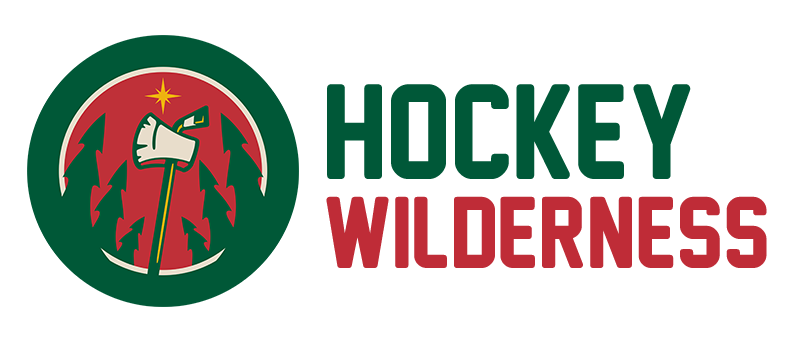

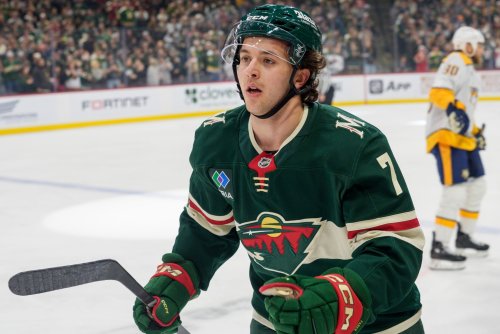
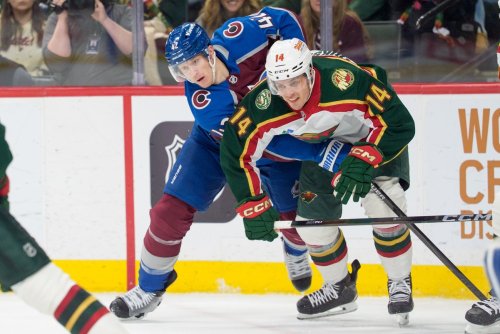



Recommended Comments
Join the conversation
You can post now and register later. If you have an account, sign in now to post with your account.
Note: Your post will require moderator approval before it will be visible.